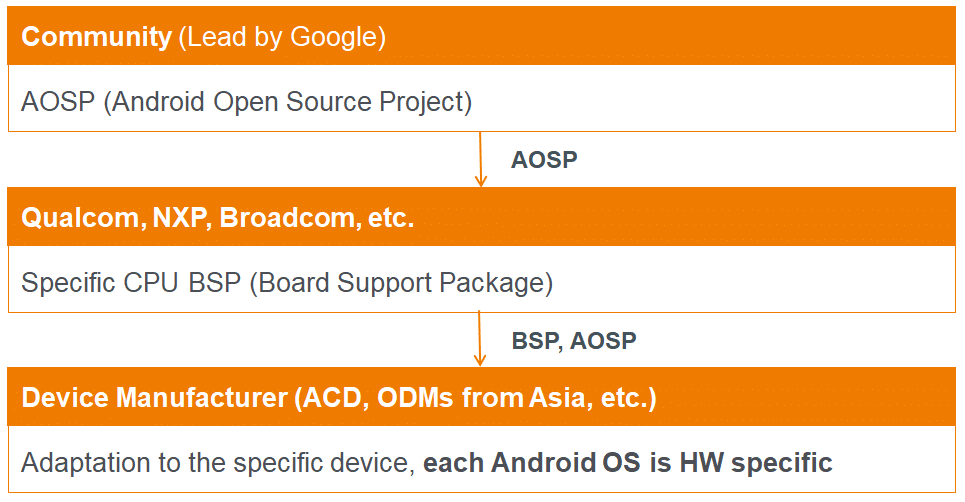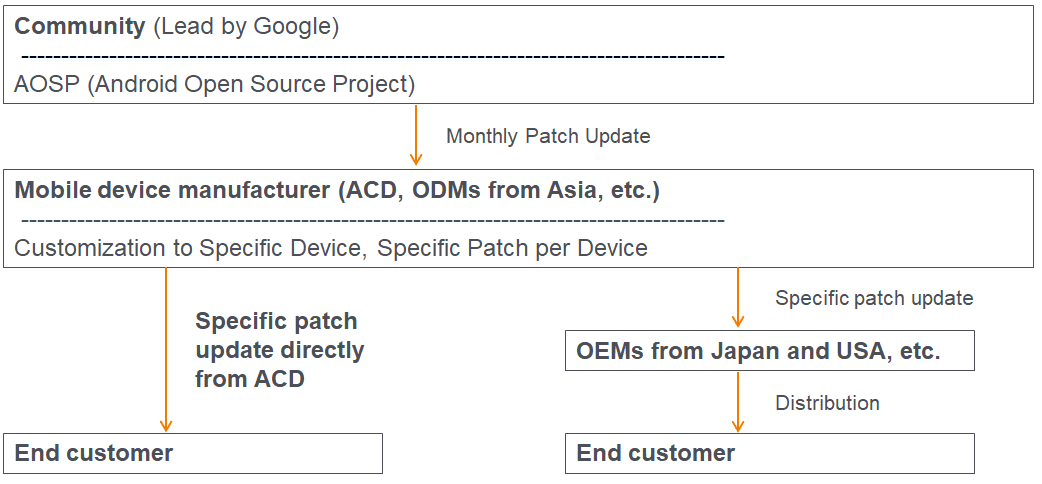AndroidTM for industrial use – here’s what you should look out for!
After having conquered the consumer smartphone and tablet market, Android™ has become the operating system of choice in many industrial sectors. There, other operating systems such as Linux or Windows® have at most a subordinate significance. This system that has been slowly established as a standard in logistics several years ago is now also the first choice in key industries such as automotive or industrial automation: intuitive, modern user interfaces based on Android™!
Android™ offers clear advantages over Linux. A significant factor is, for example, the easy and fast Java programming of applications on the basis of Android™ APIs instead of hardware-related, complex Linux C programming. Here, the developer benefits from numerous functions and services that Android™ already provides as standard. For mobile applications, Android™ is per se the more suitable operating system, optimised for touch operation and long operating time through optimal energy management. In addition, developers of stationary devices and systems also rely on the stylish and modern Android™ as a user interface or operating system.
For a company, it is a strategic decision which operating system or user interface to choose for the next few years. This raises a number of questions that need to be considered in advance. In the following we want to answer these questions.
What is the difference between Android™ and Windows®?
In principle, Android™ is an embedded operating system, i.e. it is always adapted to the respective, specific hardware ARM CPU and accordingly only runs on this one hardware. The following picture illustrates a typical development process of an Android™ device:

From an open source code, the chip producer creates a new programme code that is adapted by the end device manufacturer to his specific device. This is fundamentally different from a Windows® desktop system, which works on all x86 compatible chipsets and is sold via licences. With these licences, one acquires the corresponding support, which includes updates and security patches during the supported lifetime. Android™, on the other hand, is free of charge and for this reason no support or maintenance is purchased. This would also not be technically possible, as every Android™ OS is hardware-specific, as explained above.
Nevertheless, how is money earned with an open source product?
The exciting question from Google’s point of view is, of course, how to earn money with an open source product. Google has come up with a trick for this, the recertification GMS – Google Mobile Services, probably a milestone in the platform economy. As a user, you only get certain additional services if you accept licence conditions and pay for the whole thing with your data – services for data. Of course, this works because these services offer a great additional benefit for the end user (Playstore, Google Maps, etc.) and access to the user data is widely accepted as a private user. In addition, there is the label “Enterprise Recommended”. This label is supposed to guarantee a special industrial suitability, i.e. the manufacturers commit to providing security updates for three years, i.e. a kind of voluntary commitment. GMS recertification is the prerequisite for the label, i.e. services for data again.
Is this approach satisfactory for an industrial customer? As a rule, no. Normally, in the industrial environment, one wants significantly longer supported update runtimes and, above all, supremacy over all data.
How are updates and upgrades provided?
As mentioned at the beginning, updates (e.g. security patches, bug fixes, etc.) and upgrades (a newer Android™ version) are hardware-specific and can only be provided by the manufacturer. The basic process is as illustrated in the left path of the diagram below. The manufacturer checks the monthly updates from the open source project or other sources and uses them to create the specific patch or new image, which can then be distributed to its own customers at regular intervals. There is no automatism in this. The updates of the open source project cannot be used without further processing steps, especially if they are to be used for an older Android™ version. This is very important for many customers in logistics and industry, as industrial devices are not supposed to be replaced after three years.
Of course, it is interesting to know who the manufacturer of a device or the owner of the Android™ source code actually is. Especially with large, international brands, the manufacturer of the device is usually an Asian subcontractor and never the brand itself (see right-hand path in the diagram below). This multi-level process can work, but patching is always a matter of trust.

Test who commits longer – what strategies can be used when selecting an Android™ industrial device?
As we have learned, there are three different questions to be answered:
1. How secure is my data or is data security important to me?
If data security is not crucial for my specific use case, the use of a GMS-certified device or even a smartphone is a possible approach. If data security is very important for me, a device without GMS is definitely necessary.
Basically, there are the following possibilities:
a) I use a smartphone and accept the factors associated with it, such as data security, lack of long-term availability, etc.
b) I use a GMS/Recommended device and accept the following
c) I seal off my network so that the device never gets any outside contact
d) I use an industrial Android™ operating system that does not include Google services
e) I use a GMS/Recommended device and also use a GMS Blocker, so I subsequently create an industrial Android™ device, which is somewhat paradoxical, but is often the practice of the big brands
For industrial applications, we recommend the use of an explicit industrial Android™ operating system, e.g. the Android™ Industrial+ from ACD Elektronik or similar systems, free of third-party services and with verifiable long-term availability. Especially when using low-cost devices, one has the additional risk of an uncontrolled supply chain of the manufacturer, so that these devices are often already infected with malware ex works, which in turn only serve the purpose of data leakage.
2. How long does my provider offer updates and upgrades or how long do I want to use my Android™ hardware?
Here, too, one will not be successful in the industrial environment with useful lives of less than three years. Two things need to be considered: Firstly, the availability of the hardware, and secondly, the long-term availability of upgrades and updates for the operating system on this hardware. Preferably, companies should be selected that provide long-term support for their hardware platform, both in terms of repairing the devices and replacing changing parts and components. On the other hand, the provider should also offer long-term software can provide support. Our recommendation is always direct support and not a multi-stage procedure in which the actual service provider for updates is ultimately unknown. And it should also be clear that serious support is not available for free, so stay away from low-cost providers.
3. How do I want to manage my devices?
In the industrial environment, an administrator usually manages not just one or a few devices, but a larger number. Therefore, supporting tools for installation, updates and setting optimisation are an important differentiating factor for the decision. It is therefore important to carefully check which tools the provider offers, how well the devices can be integrated and what additional costs are incurred. Important in this context is an MDM, a mobile device manager. With this, the devices can be managed directly in the field or updates and upgrades can be installed on the devices. If a manufacturer does not have its own tool, third-party providers must be used, sometimes at significantly higher costs.
Summary:
Android™ as an operating system is chic and modern. Due to its embedded properties, i.e. the fixed link to an ARM hardware platform, support and long-term availability are very manufacturer-dependent. When choosing, it is important to consider data security, long-term availability and management of the devices.